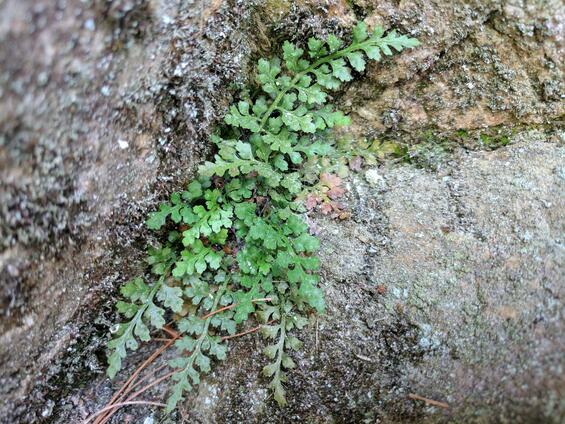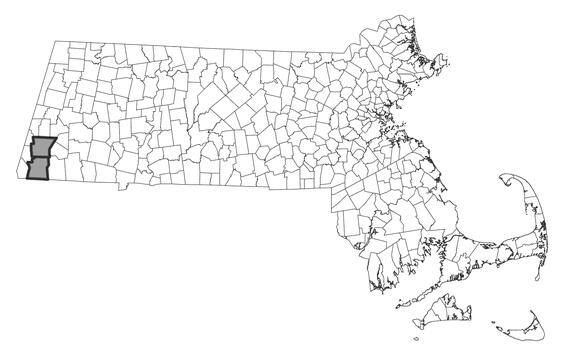- Scientific name: Asplenium montanum Willd.
- Species of Greatest Conservation Need (MA State Wildlife Action Plan)
- Endangered (MA Endangered Species Act)
Description

Mountain spleenwort. Photo credit: Robert Wernerehl
Mountain spleenwort, a member of the spleenwort family (Aspleniaceae), is a tiny, delicate, evergreen fern that grows in drooping tufts in dry to moist rock crevices. Its slightly leathery, 5-20 cm (2-8 in) long fronds end in blades (the flattened, expanded portions of leaves) that are mostly deltoid-lanceolate, or broadly triangular, in general outline. The pinnae (first divisions of compound fern fronds) occur in five to twelve pairs and have either no stalks or very short ones. The elongate sori (clusters of spore-producing structures) occur on the lower surface of the fronds and have thin, scale-like coverings called indusia that are attached on one side. The 2-10 cm (¾-4 in) long stipe (stalk of a fern frond) is brown along the lower two-thirds of its length; the frond’s midrib is flattened and green.
Both wall-rue spleenwort (Asplenium ruta-muraria) and fragile fern (Cystopteris fragilis) superficially resemble mountain spleenwort; however, they occur in different types of habitats. Wall-rue spleenwort grows on limestone and calcareous rocks, and fragile fern grows in soil that is near neutral on slope and ledges. In contrast, mountain spleenwort grows only on non-calcareous rock. Unlike mountain spleenwort, wall-rue spleenwort does not have a dark stipe. Finally, fragile fern has from eight to eighteen pairs of pinnae, compared to the five to twelve pairs of mountain spleenwort.
Population status
Mountain spleenwort is listed under the Massachusetts Endangered Species Act as endangered. All listed species are protected from killing, collecting, possessing, or sale and from activities that would destroy habitat and thus directly or indirectly cause mortality or disrupt critical behaviors. There are two populations that have been verified since 1999 in two towns in Berkshire County and four historical occurrences which have not been relocated in the past 25 years.
Distribution and abundance
The documented range of mountain spleenwort extends from southern Vermont, Massachusetts, and southern New York to Indiana and Tennessee, and south to Georgia and Alabama. Mountain spleenwort is considered critically imperiled in Indiana, Massachusetts, New Jersey, Rhode Island, and Vermont, imperiled in Connecticut and New York. It was present historically in Missouri.

Distribution in Massachusetts
1999-2024
Based on records in the Natural Heritage Database
Habitat
Mountain spleenwort is found growing as tufts lodged in crevices and cracks in non-calcareous rock outcrops, often ones protected by small overhangs. This species prefers acidic conditions. It can be found in association with both hemlock and upland oak communities and favors dense to medium shade. Specific habitats in Massachusetts include vertical ledges of stratified rocks and barren, sunny quartzite cliffs, under an overhanging ledge. Historical Massachusetts habitats include a crevice in the bare face of a cliff and the lower shoulder of a mountain. Associated species include hayscented fern (Dennstaedtia punctilobula) and Dicranum spp. mosses.
Healthy habitats are vital for supporting native wildlife and plants. Explore habitats and learn about conservation and restoration in Massachusetts.
Threats
Causes of its rarity in the state include the scarcity of its habitat and the fact that Massachusetts is at the northern edge of its range. It is a fragile species and needs to be avoided by rock climbers. All active management of rare plant populations (including invasive species removal) is subject to review under the Massachusetts Endangered Species Act and should be planned in close consultation with the NHESP.
Contact
| Date published: | April 7, 2025 |
|---|